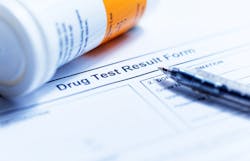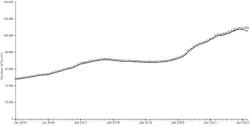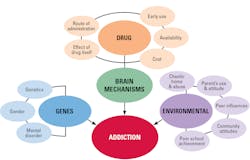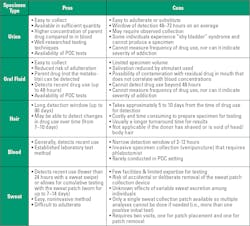Drug of abuse testing and therapeutic drug monitoring
In pharmacology, a drug is a chemical substance that produces a biological effect when administered to a living organism. Drugs are classified in various ways. One widely used classification system is the Anatomical Therapeutic Chemical Classification System (ATC system).1 In this system, drugs are classified based on the active ingredients for the organ or system on which they act and their therapeutic, pharmacological, and chemical properties. Pharmaceutical drugs, also called medicine or therapeutic drugs, are chemical substances used to treat, cure, prevent, or diagnose a disease or to promote well-being. Depending on the level of control, these drugs are classified as prescription drugs or over-the-counter (OTC) drugs. US Pharmacopeia (USP) currently categorizes a drug or drug component under one of 49 different therapeutic classes such as analgesics, including opioids and non-opioids; anesthetics; central nervous system agents, including amphetamines; and so forth.2 There are some drugs that mimic or alter the neurotransmitters in the central nervous system and thereby when consumed, alter perception, mood, consciousness, cognition, or behavior of the person.3 People who consume such drugs for pleasure suffer from substance abuse. When a person is unable to stop consuming a drug(s) and the drug(s) takes control of the person, the situation is called drug addiction.
Problem of substance abuse
Substance abuse is a serious concern globally, including the United States. According to results from the 2020 National Survey on Drug Use and Health (NSDUH) conducted annually by the Substance Abuse and Mental Health Services Administration (SAMHSA), 40.3 million people aged 12 or older had a substance use disorder (SUD) in the past year, including 28.3 million with alcohol use disorder, 18.4 million with an illicit drug use disorder, and 6.5 million with both alcohol use disorder and an illicit drug use disorder (see Figure 1).4
Deaths due to drug overdoses have been on the rise for years in the United States, but the COVID-19 pandemic worsened the situation further. Based on a provisional report from the Centers for Disease Control and Prevention (CDC), there were more than 100,000 deaths from drug overdose in 2021. The CDC data shows annual deaths were nearly 50% higher in 2021 than in 2019 (see Figure 2).5
People in all phases of life can be addicted to a drug of abuse, which can have various consequences:
Teens who use drugs may do poorly in school or drop out.6 Using drugs at an early age, when the brain is still developing may cause lasting brain changes and put the user at increased risk of dependence in adult life.7
Adults who use drugs may have problems of clear thinking, remembering, and paying attention. Drug addiction impairs social behaviors and affects work performance and personal relationships.
Parents’ drug use results in chaotic, stress-filled homes and probable child abuse and neglect.8 Such conditions harm the well-being and development of children, and they also may resort to drug abuse.9
Pregnant women who abuse drugs during pregnancy risk premature and underweight babies. This situation also affects the child’s ability to learn and behavior later in life.10 The child may also become dependent on opioids or other drugs used by the mother during pregnancy, a condition called neonatal abstinence syndrome (NAS).
Scientific reasons behind drug addiction
Drug addiction manifests as a behavioral disorder where the patient exhibits compulsive drug-seeking behavior. It is a brain disorder, that is caused by functional changes to the brain circuits involved in reward, stress, and self-control. Brain images of people with addiction have shown changes in the areas of the brain that control judgement, decision-making, learning, memory, and behavior.11 Those changes may last a long time after a person has stopped taking drugs.12 Addiction is dependent on various factors, including genetic and environmental factors. Figure 3 shows the factors that impact drug addiction.3
Drug testing
Situations requiring drug testing
Drug addiction is preventable and treatable. If left untreated, it can last a lifetime and may lead to death. Drug addiction can be determined by drug testing. Although, drug testing may be required for clinical or nonclinical reasons. A clinical reason would be when a doctor requests drug testing to monitor if a patient is taking the right amount of a prescribed opioid medication. Nonclinical reasons include the following:
- Employment: Employers may request drug testing before recruitment or on-the-job.
- Sports: Athletes may be required to get tested for drugs before and/or after a competition.
- Legal or forensic purposes: Court cases may order drug testing for criminal trial or motor vehicle accident investigation.
Specimen types for drug testing
The U.S. Department of Health and Human Services (DHHS) set guidelines for drug testing. Laboratories performing drug testing include a centralized clinical chemistry laboratory, point-of-care (POC) facilities, physician’s office labs, and emergency centers. Urine is the most used sample type for drug testing. The other possible matrices are hair, blood, sweat, and oral fluid (saliva). Every specimen type has its pros and cons as shown in Table 1.13
Drug of abuse testing
Drug abuse testing generally follows two steps: initial screening followed by a confirmatory test.15 Initial drug screening is carried out most of the time using an immunoassay. In the immunoassay method, an antigen (drug) and antibody are made to bind to identify drug analytes. The antibodies are produced to be drug specific. A known amount of antibody is added to a specimen, along with a drug that has been labeled to distinguish it from the drug in a donor’s urine specimen. The labeled drug and the unlabeled drug (if any) compete for the antibody to form an antigen-antibody complex. The ratio of the labeled and unlabeled drug bound to the antibody allows the measurement of the amount of drug in the donor’s urine specimen. Advantages of immunoassays are their ease of use, fast turnaround times, lower costs, and results may be qualitative or semi-qualitative. Immunoassays may be of different types:
- Enzyme immunoassays (EIA)
- Cloned enzyme donor immunoassay (CEDIA)
- Fluorescence polarization immunoassay (FPIA)
- Kinetic interaction of microparticles in solution (KIMS)
- Microplate enzyme-linked immunosorbent assay (ELISA)
Specimens that are positive by immunoassay need to be confirmed using a different analytical method. A confirmatory test method needs to identify and quantify the drug or drug metabolite. The analytical method used for the confirmatory drug test must combine gas (GC) or liquid (LC) chromatographic separation and mass spectrometric (MS) identification. Urine specimens must undergo a specimen preparation process (i.e., extraction) prior to GC/MS analysis and may require preparation prior to LC/MS/MS analysis.
Therapeutic drug monitoring
Some therapeutic drugs also need testing in certain circumstances. Therapeutic drug monitoring is required to measure the amount of a medicine or its metabolites in the blood/plasma or serum at a specific time point to determine if a patient’s drug concentrations are within the therapeutic range and are neither subtherapeutic nor potentially toxic. It is used to determine the best dosages for patients on certain hard-to-dose medicines.16
Some of the most common medicines that need monitoring are shown in Table 2.
The methods used for therapeutic drug monitoring are high performance liquid chromatography (HPLC), HPLC combined with mass spectrometry, or immunoassays such as enzyme immunoassay (EIA), fluorescence polarization immunoassay (FPIA), and microplate enzyme-linked immunosorbent assay (ELISA).
Conclusion
Drug abuse devastates families and is a great menace for the society. Drug addiction in individuals results in broken families, increased crime, accidents, death, overburdened jails and prisons, reduced employee productivity, increased costs on foster care, healthcare, and treatment.
As prevention is better than cure, all efforts should be made to prevent drug abuse in individuals. Strict supervision by parents of their children, family-based, school-based and community-based programs to educate on the ill effects of drug abuse and how to control mind and temptations should be followed.
Moreover, early and accurate detection of substance abuse is essential and the first step towards identification and treatment of the individuals under influence of drugs.
References
- Guidelines for ATC classification and DDD assignment. World Health Organization Collaborating Centre for Drug Statistics Methodology. Published 2011. Accessed October 27, 2022. https://www.whocc.no/filearchive/publications/2011guidelines.pdf.
- USP Medicare model guidelines v. 7.0. United States Pharmacopoeia. Accessed October 27, 2022. https://www.usp.org/sites/default/files/usp/document/our-work/healthcare-quality-safety/uspmmg_v7_0_w_exampledrugs_rev170206.pdf.
- Drugs and the Brain. National Institute on Drug Abuse. Published July 10, 2020. Accessed October 27, 2022. https://www.drugabuse.gov/publications/drugs-brains-behavior-science-addiction/drugs-brain.
- Key substance use and mental health indicators in the United States: Results from the 2019 National Survey on Drug Use and Health (HHS Publication No. PEP20-07-01-001, NSDUH Series H-55). Rockville, MD: Center for Behavioral Health Statistics and Quality, Substance Abuse and Mental Health Services Administration. Substance Abuse and Mental Health Services Administration. Published 2020. Accessed October 27, 2022. Retrieved from https://www.samhsa.gov/data/.
- Ahmad FB, Cisewski JA, Rossen LM, Sutton P. Provisional drug overdose death counts. National Center for Health Statistics. Published 2022. Accessed October 27, 2022. https://www.cdc.gov/nchs/nvss/vsrr/drug-overdose-data.htm.
- Tice P, Lipari R, Van Horn S. Substance Use among 12th Grade Aged Youths, by Dropout Status. Rockville, MD: Center for Health Statistics and Quality, Substance Abuse and Mental Health Administration. Published August 15, 2017. Accessed October 27, 2022. https://www.samhsa.gov/data/sites/default/files/report_3196/ShortReport-3196.html.
- Chen CY, Storr CL, Anthony JC. Early-onset drug use and risk for drug dependence problems. Addict Behav. 2009;34(3):319-22. doi: 10.1016/j.addbeh.2008.10.021.
- Lander L, Howsare J, Byrne M. The impact of substance use disorders on families and children: from theory to practice. Soc Work Public Health. 2013;28(3-4):194-205. doi: 10.1080/19371918.2013.759005.
- Simmons LA, Havens JR, Whiting JB, Holz JL, Bada H. Illicit drug use among women with children in the United States: 2002-2003. Ann Epidemiol. 2009;19(3):187-93. doi: 10.1016/j.annepidem.2008.12.007.
- Shankaran S, Lester BM, Das A, Bauer CR, Bada HS, Lagasse L, Higgins R. Impact of maternal substance use during pregnancy on childhood outcome. Semin Fetal Neonatal Med. 2007;12(2):143-50. doi: 10.1016/j.siny.2007.01.002.
- Fowler JS, Volkow ND, Kassed CA, Chang L. Imaging the addicted human brain. Sci Pract Perspect. 2007;3(2):4-16. doi: 10.1151/spp07324.
- Goldstein RZ, Volkow ND. Dysfunction of the prefrontal cortex in addiction: neuroimaging findings and clinical implications. Nat Rev Neurosci. 2011;20;12(11):652-69. doi: 10.1038/nrn3119.
- Hadland SE, Levy S. Objective Testing: Urine and Other Drug Tests. Child Adolesc Psychiatr Clin N Am. 2016;25(3):549-65. doi: 10.1016/j.chc.2016.02.005.
- Drug Scheduling. DEA. Published July 10, 2018. Accessed October 27, 2022. https://www.dea.gov/drug-information/drug-scheduling.
- Medical Review Officer Guidance Manual for Federal Workplace Drug Testing Programs. Department of Health and Human Services Substance Abuse & Mental Health Services Administration (SAMHSA). Revised March 2018. Accessed October 27, 2022. https://www.samhsa.gov/sites/default/files/workplace/mro-guidance-manual-oct2017_2.pdf.
- Mabilat C, Gros MF, Nicolau D, Mouton JW, et al. Diagnostic and medical needs for therapeutic drug monitoring of antibiotics. Eur J Clin Microbiol Infect Dis. 2020;39(5):791-797. doi: 10.1007/s10096-019-03769-8
About the Author

Rajasri Chandra, MS, MBA
is a global marketing leader with expertise in managing upstream, downstream, strategic, tactical, traditional, and digital marketing in biotech, in vitro diagnostics, life sciences, and pharmaceutical industries. Raj is an orchestrator of go-to-market strategies driving complete product life cycle from ideation to commercialization.





